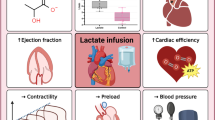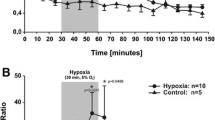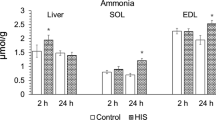Summary
On closed chest anesthetized dogs the myocardial consumption of lactate, glucose, free fatty acids (FFA) and oxygen was measured while the concentration of lactate and glucose was enhanced simultaneously. 17 min after the beginning of the infusion of lactate (4.5–9.0 mg/kg×min) and glucose (10 mg/kg×min) the lactate concentration was increased from 15 to 37 mg/100 ml, 17 min later a concentration of 69 mg/100 ml was reached. At the same time myocardial lactate consumption increased from 1.7 to 7.1 and 9.4 mg/100 g×min and the myocardial oxygen extraction ratio rose from 21 to 74 and 87%. During the infusions the glucose concentration increased from 86 to 142 and 162 mg/100 ml. At first the glucose consumption increased from 1.9 to 3.5 mg/100 g×min but during the second infusion period glucose extraction decreased to 1.8 mg/100 g×min. The corresponding oxygen extraction ratios of glucose were 20, 37 and 17%. FFA extraction continuously went down during the infusions from 4.8 to 2.4 and 1.2 μval/100 g×min. The oxygen extraction ratios of FFA decreased from 36 to 16 and 8%. This is probably due to the decrease of the FFA concentration caused by the combined infusion of lactate and glucose. During the infusions respiratory quotient increased from 0.8 to 0.93 and 0.95. The sum of the myocardial oxygen extraction ratios was 77% under control conditions and 126 and 118% during the infusion period.
These experiments show that heart muscle can gain nearly all its energy requirements solely by the oxydation of lactate. It can be calculated that heart muscle can decrease the high lactate concentration during increased muscle work to a considerable amount. Glucose oxydation is inhibited and glycogen synthesis is stimulated in the myocardium by a high lactate concentration. Intermediary mechanisms suitable to understand these findings are discussed.
Zusammenfassung
Bei narkotisierten Hunden wurde bei geschlossenem Thorax der Herzstoffwechsel bei gleichzeitig erhöhter Konzentration von Milchsäure (MS) und Glucose untersucht. Gemessen wurden die arteriovenösen Differenzen für MS, Glucose und freie Fettsäuren (FFS) sowie der O2-Verbrauch und die Durchblutung des Herzmuskels.
17 min nach dem Beginn der Infusion von MS (4,5–9,0 mg/kg·min) und Glucose (10 mg/kg·min) war die MS-Konzentration von 15 auf 37 mg/100 ml angestiegen, nach 34 min hatte sie einen Wert von 69 mg/100 ml erreicht. Gleichzeitig stieg die MS-Aufnahme durch den Herzmuskel von 1,7 auf 7,1 und 9,4 mg/min·100 g an, der Anteil der MS am O2-Verbrauch des Herzens betrug 21, 74 und 87%. Die Glucosekonzentration stieg während der Infusion von 86 auf 142 und 162 mg/100 ml an. Die Glucoseaufnahme stieg dabei zunächst von 1,9 auf 3,5 mg/min·100 g an, fiel dann jedoch auf 1,8 mg/min·100 g ab. Das entspricht einem Anteil der Glucose am O2-Verbrauch von 20, 37 und 17%. Der FFS-Verbrauch fiel gleichzeitig von 4,8 auf 2,4 und 1,2 μval/min·100 g ab. Das entspricht einem Anteil am O2-Verbrauch von 36, 16 und 8%. Diese Abnahme des FFS-Verbrauchs ist sicherlich die Folge der durch die MS und Glucose gesenkten FFS-Konzentration. Der RQ stieg während der Infusionen von 0,80 auf 0,93 und 0,95 an. Die Summen der Anteile der Substrate, bezogen auf den O2-Verbrauch des Herzens, betrugen unter Ausgangsbedingungen 77%, während der Infusionen 126 und 118%.
Die Befunde zeigen, daß der Herzmuskel seinen Energiebedarf überwiegend durch die Oxydation der MS decken kann. Es läßt sich berechnen, daß dadurch die arterielle MS-Konzentration bei Muskelarbeit in beachtlichem Maße gesenkt wird. Durch den hohen MS-Verbrauch wird der Abbau der Glucose gehemmt, so daß wahrscheinlich Glykogen gespeichert wird. Mechanismen im Intermediärstoffwechsel, die diese Befunde erklären können, werden diskutiert.
Similar content being viewed by others
Literatur
Altman, P. L.: Handbook of Circulation. Philadelphia and London: W. B. Saunders Company 1959.
Bartelmai, W., u. R. Czok: Enzymatische Bestimmung der Glucose in Blut, Liquor und Harn. Klin. Wschr. 40, 585–589 (1962).
Bing, R. J.: Cardiac Metabolism. Physiol. Rev. 45, 171–213 (1965).
Bowman, R. H.: Effects of diabetes, fatty acids, and ketone bodies on tricarboxylic acid cycle metabolism in the perfused rat heart. J. biol. Chem. 241, 3041–3048 (1966).
Danforth, W. H., J. J. McKinsey, and J. T. Stewart: Transport and Phosphorylation of glucose by the dog heart. J. Physiol. (Lond.) 162, 367–384 (1962).
Dole, V. P., and H. Meinertz: Microdetermination of long-chain fatty acids in plasma and tissues. J. biol. Chem. 235, 2595–2599 (1960).
Garland, P. B., P. J. Randle, and E. A. Newsholme: Citrate as an intermediary in the inhibition of phosphofructokinase in rat heart muscle by fatty acids, ketone bodies, pyruvate, diabetes and starvation. Nature (Lond.) 200, 169–170 (1963).
Gercken, G.: Die quantitative enzymatische Dehydrierung von L-(+)-Lactat für die Mikroanalyse. Hoppe-Seylers Z. physiol. Chem. 320, 180–186 (1960).
Grosse-Brockhoff, F.: Herzstoffwechsel unter verschiedenen physiologischen, pharmakologischen und pathologischen Bedingungen. Arzneimittel-Forsch. 16, 189–199 (1966).
Hirche, Hj., u. S. Koike: Hemmung der Aufnahme und des Abbaus der Glucose im Herzmuskel narkotisierter Hunde durch die freien Fettsäuren. Pflügers Arch. ges. Physiol. 280, 158–164 (1964).
——, u. H. D. Langohr: Hemmung der Milchsäureaufnahme im Herzmuskel narkotisierter Hunde durch hohe arterielle Konzentration der freien Fettsäuren. Pflügers Arch. ges. Physiol. 293, 208 (1967).
——, u. G. Röhner: Änderungen der Substrataufnahme des Herzmuskels bei induzierten Änderungen der arteriellen Substratkonzentration. Pflügers Arch. ges. Physiol. 278, 408–422 (1963).
Issekutz, B., H. I. Miller, P. Paul, and K. Rodahl: Effect of lactic acid on free fatty acids and glucose oxidation in dogs. Amer. J. Physiol. 209, 1137–1144 (1965).
Keul, J., E. Doll, H. Steim, U. Fleer u. H. Reindell: Über den Stoffwechsel des Herzens bei Hochleistungssportlern. III. Der oxydative Stoffwechsel des trainierten menschlichen Herzens unter verschiedenen Arbeitsbedingungen. Z. Kreisl.-Forsch. 55, 477–488 (1966).
Lochner, W., u. Hj. Hirche: Kohlenhydratstoffwechsel bei Herzerkrankungen. In: D-Glucose und verwandte Verbindungen in Medizin und Biologie. Stuttgart: Enke 1966.
——, u. M. Nasseri: Über den venösen Sauerstoffdruck, die Einstellung der Coronardurchblutung und den Kohlenhydratstoffwechsel des Herzens bei Muskelarbeit. Pflügers Arch. ges. Physiol. 269, 407–416 (1959).
Lochner, W., u. S. Oswald: Eine elektromagnetische Stromuhr zur Messung des Coronarsinusausflusses. Pflügers Arch. ges. Physiol. 281, 305–308 (1964).
Williamson, J. R.: Effects of insulin and diet on the metabolism of L(+)-lactate and glucose by the perfused rat heart. Biochem. J. 83, 377–383 (1962).
——, and E. A. Jones: Inhibition of glycolysis by pyruvate in relation to the accumulation of citric acid cycle intermediates in the perfused rat heart. Nature (Lond.) 203, 1171–1173 (1964).
Author information
Authors and Affiliations
Additional information
Mit Unterstützung der Deutschen Forschungsgemeinschaft.
Stipendiat der Alexander von Humboldt-Stiftung.
Rights and permissions
About this article
Cite this article
Hirche, H., Koike, S. Hemmung der Glucoseaufnahme im Herzmuskel narkotisierter Hunde durch hohe arterielle Milchsäurekonzentration. Pflugers Arch. 293, 199–207 (1967). https://doi.org/10.1007/BF00417118
Received:
Issue Date:
DOI: https://doi.org/10.1007/BF00417118




